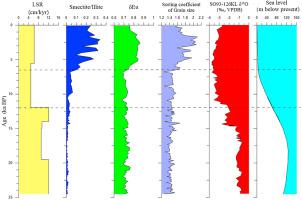当前位置:
X-MOL 学术
›
Quat. Int.
›
论文详情
Our official English website, www.x-mol.net, welcomes your feedback! (Note: you will need to create a separate account there.)
Evolution of sediment provenances and transport processes in the central Bay of Bengal since the Last Glacial Maximum
Quaternary International ( IF 2.2 ) Pub Date : 2020-12-01 , DOI: 10.1016/j.quaint.2020.12.007 Wenxing Ye , Shengfa Liu , Dejiang Fan , Hui Zhang , Peng Cao , Hui-Juan Pan , Jingrui Li , Xiaoyan Li , Xisheng Fang , Somkiat Khokiattiwong , Narumol Kornkanitnan , Xuefa Shi
Quaternary International ( IF 2.2 ) Pub Date : 2020-12-01 , DOI: 10.1016/j.quaint.2020.12.007 Wenxing Ye , Shengfa Liu , Dejiang Fan , Hui Zhang , Peng Cao , Hui-Juan Pan , Jingrui Li , Xiaoyan Li , Xisheng Fang , Somkiat Khokiattiwong , Narumol Kornkanitnan , Xuefa Shi

|
Abstract To investigate the evolution of sediment provenances and transport processes in the central Bay of Bengal (BoB) since the Last Glacial Maximum, we present a comprehensive study on the grain size, clay minerals, rare earth elements, and accelerator mass spectrometry (AMS)14C analyses of the core BoB-24 sediments. Six AMS14C dates were obtained from planktonic foraminiferal Neogloboquedrina dutertrei (N. dutertrei) extracted from the core to reconstruct a reliable age model. The assemblage of clay minerals and the (La/Yb)UCC–δEu relationship indicated that the core contained a mixture of sediments from the Himalayas and Indian Peninsula. These results showed that the Himalayas were the main source of erosional materials during 25–6.5 ka BP, whereas those from the Indian Peninsula increased since the mid-Holocene. Between 25 ka BP and 12 ka BP, the sea level was relatively low, and a large amount of terrigenous detrital material were directly transported from the Himalayas and the Tibet Plateau to the study area by submarine canyons, forming a deposition center on the Bengal Fan. Between 12 ka BP and 6.5 ka BP, the sea level gradually rose and the Indian summer monsoon gradually strengthened, whereas the sedimentation rate and the amount of material transported from the Ganges–Brahmaputra River decreased greatly; the deposition center transferred from the Bengal Fan to the shelf of the BoB. Since 6.5 ka BP, the sea level has risen, reaching its present position. A high sea level and a strengthened East Indian Coastal Current resulted in an increase of material contribution from India, while the deposition center was on the shelf of the BoB. Overall, this study confirmed that both sea level fluctuations and variations of the Indian summer monsoon controlled the evolution of sediment provenances in the central BoB and transfer of the deposition center from the Bengal Fan to the continental shelf. This typical sedimentary pattern observed in the northeastern Indian Ocean improves our general understanding of past land–sea interactions.
中文翻译:

自末次盛冰期以来孟加拉湾中部沉积物来源和输送过程的演变
摘要 为了研究自末次盛冰期以来孟加拉湾中部 (BoB) 沉积物来源和输送过程的演变,我们对粒度、粘土矿物、稀土元素和加速器质谱 (AMS) 进行了综合研究。岩心 BoB-24 沉积物的 14C 分析。从从核心提取的浮游有孔虫 Neogloboquedrina dutertrei (N. dutertrei) 中获得了六个 AMS14C 日期,以重建可靠的年龄模型。粘土矿物的组合和 (La/Yb)UCC-δEu 关系表明,岩心包含来自喜马拉雅山和印度半岛的沉积物混合物。这些结果表明喜马拉雅山是 25-6.5 ka BP 期间侵蚀物质的主要来源,而印度半岛的侵蚀物质自全新世中期以来有所增加。25 ka BP至12 ka BP之间海平面较低,大量陆源碎屑物质通过海底峡谷从喜马拉雅山和青藏高原直接输送到研究区,形成孟加拉扇沉积中心. 12 ka BP至6.5 ka BP之间,海平面逐渐上升,印度夏季风逐渐增强,而恒河-雅鲁藏布江的沉积速率和输送物质量大大减少;沉积中心从孟加拉扇转移到 BoB 的架子上。自 6.5 ka BP 以来,海平面上升,达到现在的位置。海平面升高和东印度海流加强导致印度物质贡献增加,沉积中心位于BoB大陆架上。全面的,该研究证实,海平面波动和印度夏季风的变化控制了 BoB 中部沉积物来源的演变以及沉积中心从孟加拉扇向大陆架的转移。在印度洋东北部观察到的这种典型的沉积模式提高了我们对过去陆海相互作用的总体了解。
更新日期:2020-12-01
中文翻译:

自末次盛冰期以来孟加拉湾中部沉积物来源和输送过程的演变
摘要 为了研究自末次盛冰期以来孟加拉湾中部 (BoB) 沉积物来源和输送过程的演变,我们对粒度、粘土矿物、稀土元素和加速器质谱 (AMS) 进行了综合研究。岩心 BoB-24 沉积物的 14C 分析。从从核心提取的浮游有孔虫 Neogloboquedrina dutertrei (N. dutertrei) 中获得了六个 AMS14C 日期,以重建可靠的年龄模型。粘土矿物的组合和 (La/Yb)UCC-δEu 关系表明,岩心包含来自喜马拉雅山和印度半岛的沉积物混合物。这些结果表明喜马拉雅山是 25-6.5 ka BP 期间侵蚀物质的主要来源,而印度半岛的侵蚀物质自全新世中期以来有所增加。25 ka BP至12 ka BP之间海平面较低,大量陆源碎屑物质通过海底峡谷从喜马拉雅山和青藏高原直接输送到研究区,形成孟加拉扇沉积中心. 12 ka BP至6.5 ka BP之间,海平面逐渐上升,印度夏季风逐渐增强,而恒河-雅鲁藏布江的沉积速率和输送物质量大大减少;沉积中心从孟加拉扇转移到 BoB 的架子上。自 6.5 ka BP 以来,海平面上升,达到现在的位置。海平面升高和东印度海流加强导致印度物质贡献增加,沉积中心位于BoB大陆架上。全面的,该研究证实,海平面波动和印度夏季风的变化控制了 BoB 中部沉积物来源的演变以及沉积中心从孟加拉扇向大陆架的转移。在印度洋东北部观察到的这种典型的沉积模式提高了我们对过去陆海相互作用的总体了解。



























 京公网安备 11010802027423号
京公网安备 11010802027423号